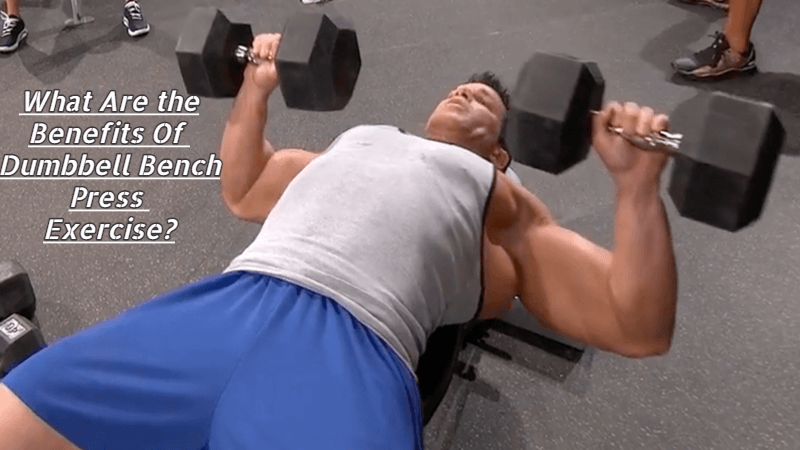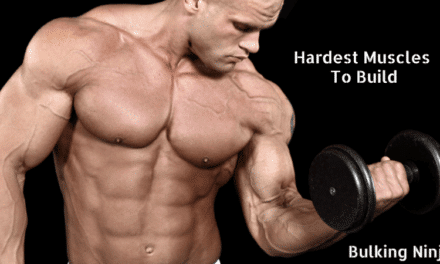Are you looking to elevate your strength training routine and sculpt a powerful upper body? If so, the benefits of dumbbell bench press exercise might just become your new best friend at the gym. This classic yet effective workout has been a cornerstone of strength training for decades, and for good reason.
In this blog post, we’ll delve into the world of dumbbell bench pressing and explore the numerous benefits it offers. From building chest muscles to enhancing overall upper body strength and even improving your posture, the dumbbell bench press is a versatile and essential exercise that deserves a closer look.
So, grab your dumbbells and get ready to uncover the incredible advantages of incorporating this exercise into your fitness regimen.
Table of Contents
- What Are the Benefits Of Dumbbell Bench Press Exercise?
- What is Dumbbell Bench Press?
- How to Do the Dumbbell Bench Press?
- Common Dumbbell Bench Press Mistakes?
- What Are The Dumbbell Bench Press Variations?
- Which Muscles Are Used In Dumbbell Bench Press?
- The Health Benefits Of Dumbbell Bench Press?
- Frequently Asked Question
- Benefits Of Dumbbell Bench Press With Dumbbells?
- Benefits Of Dumbbell Bench Press For Females?
- Incline Dumbbell Bench Press Muscles Worked?
- Benefits Of Dumbbell Shoulder Press?
- How Much Should I Dumbbell Press Compared To Bench Press?
- What Is A Good Dumbbell Bench Press Weight?
- Is it better to do bench press with dumbbells?
- Why use dumbbells for bench press?
- Average Dumbbell Bench Press? (Kg)
- What is Incline Bench Press?
- Conclusion
What Are the Benefits Of Dumbbell Bench Press Exercise?
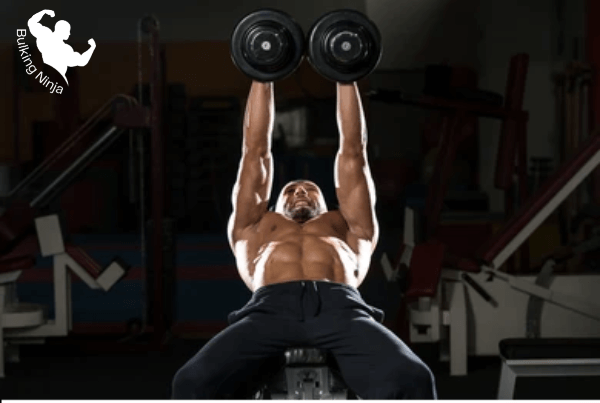
The dumbbell bench press is highly effective for muscle gain, primarily due to the following reasons, Dumbbells allow for a greater range of motion compared to a barbell, which means that you can work your muscles through a fuller stretch and contraction. This increased range of motion can lead to better muscle engagement and growth.
Dumbbells require each arm to work independently, which can help identify and correct muscle imbalances. This ensures that both sides of your body develop equally, reducing the risk of asymmetry.
Holding and controlling two separate dumbbells during the exercise demands a significant amount of stabilization from various muscle groups, including the core and stabilizer muscles. This added stabilization work can lead to more overall muscle activation and growth.
Dumbbell bench presses offer a versatile exercise that allows you to target different areas of the chest by adjusting your hand positions and angles. This variation can lead to more comprehensive muscle development.
To stimulate muscle growth, you need to gradually increase the resistance or weight you’re lifting. Dumbbells are ideal for this because you can easily incrementally increase the weight as you get stronger, promoting continuous muscle growth.
Dumbbell bench presses can be gentler on the shoulders and reduce the risk of injury, especially for individuals with shoulder issues, as each arm can move independently, reducing strain on the shoulder joints.
The exercise activates a wide range of upper body muscles, including the pectoral muscles, deltoids, triceps, and even some engagement of the biceps and forearms, leading to more comprehensive muscle development.
Overall, the dumbbell bench press is a highly effective compound exercise that not only builds chest muscles but also promotes balanced, full-body muscle development, making it a key component of many muscle gain-focused workout routines. Read more about Grow muscles faster with Best Food.
What is Dumbbell Bench Press?
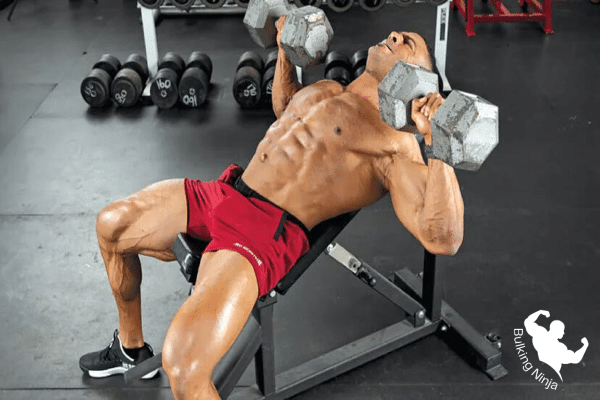
When it comes to igniting substantial chest growth and fortifying your upper body, the bench press dumbbell exercise emerges as a pinnacle choice. Unlike the standard push-up or calisthenics, the bench press with dumbbells offers a unique and targeted approach to sculpting chest muscles.
This exercise’s benefits extend beyond just growth; it encompasses comprehensive chest strengthening. By utilizing dumbbells, you tap into the distinctive advantages of isolating and challenging your chest muscles in a controlled manner.
While barbells and plate-loaded machines have their place in strength training, the bench press with dumbbells provides a specific focus on chest development that sets it apart.
Whether you’re aiming to build a robust chest, increase strength, or enhance your overall physique, the bench press with dumbbells stands as a vital cornerstone in your journey towards muscle growth and upper body supremacy.
How to Do the Dumbbell Bench Press?
To perform the Dumbbell Bench Press effectively, follow these steps:
- Preparation: Before you begin, make sure you have the weights (dumbbells) ready. If possible, have a friend assist you by handing you the dumbbells as you lie down on the bench. If you’re alone, you can start by lifting the dumbbells from the floor to your knees.
- Starting Position: Lie down on the bench with your back flat and your feet firmly planted on the floor. Grip each dumbbell firmly, and then squeeze your shoulder blades together. Your starting position should have both dumbbells over your chest, with your arms fully extended.
- Execution: Slowly lower the dumbbells down toward your chest, allowing them to move both downward and outward to the sides. Lower them until your upper arms are parallel to the floor or when the dumbbells come to chest height. Keep your elbows under your wrists at all times to maintain proper form.
- Lifting: Once the dumbbells are at chest level and your back is tight, drive them up and inward. Push the dumbbells until your hands end up back on top of your shoulders.
- Focus on Form: Throughout the exercise, ensure that your feet are actively pressing into the floor to provide stability. Be cautious not to lift the dumbbells too forcefully to avoid any risk of injury, especially to your head.
By incorporating these steps and maintaining a moderate weight, you can effectively perform the Dumbbell Bench Press. This exercise targets your chest, shoulders, and arms, and by focusing on controlled movements, you can maximize its benefits while ensuring a safe and productive workout.
Dumbbell Bench Press Sets and Reps?
The number of sets and reps for the Dumbbell Bench Press can vary depending on your fitness goals and experience level. Here are some general guidelines:
For Muscle Hypertrophy (Muscle Growth)
- Sets: 3-5 sets
- Reps: 8-12 reps per set
- Rest: 1-2 minutes between sets
If you’re aiming to build muscle size and strength, higher reps and moderate sets are effective. This range promotes muscle hypertrophy by placing sufficient tension on the muscles.
For Strength and Power
- Sets: 4-6 sets
- Reps: 4-6 reps per set
- Rest: 2-3 minutes between sets
If your primary goal is to increase your strength and power, lower reps with heavier weights and more sets are suitable. This approach helps you build maximal strength.
For Endurance and Toning
- Sets: 2-3 sets
- Reps: 15-20 reps per set
- Rest: 30 seconds to 1 minute between sets
If you’re looking to improve muscular endurance and tone your muscles without significant size or strength gains, higher reps with shorter rest intervals can be effective.
Remember to start with a weight that you can lift with proper form for the desired number of reps. As you progress, you can gradually increase the weight while maintaining good form. Always warm up before starting your sets, and cool down/stretch after your workout to prevent injury and promote flexibility. It’s also essential to listen to your body and adjust your sets and reps based on your individual needs and capabilities.
Common Dumbbell Bench Press Mistakes?
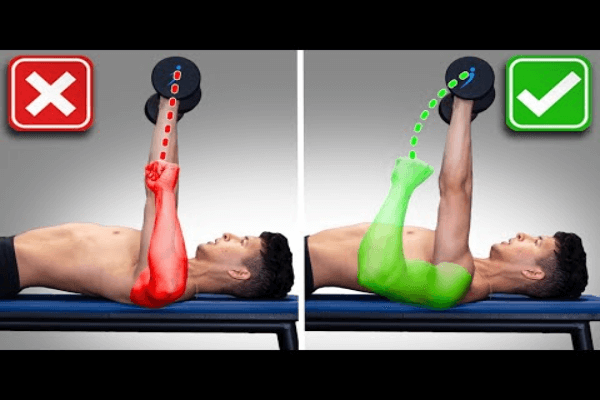
Performing the Dumbbell Bench Press with proper form is crucial to prevent injuries and maximize its benefits. Here are some common mistakes to avoid:
- Incorrect Grip
Holding the dumbbells improperly can lead to instability and reduce the effectiveness of the exercise. Ensure you have a secure grip on the dumbbells with your palms facing forward and wrists aligned.
- Excessive Weight
Trying to lift weights that are too heavy can compromise your form and increase the risk of injury. Start with a manageable weight that allows you to complete your desired reps with proper technique.
- Arching Your Back
Arching your back excessively off the bench can strain your lower back and reduce the engagement of your chest muscles. Keep your back flat against the bench throughout the exercise.
- Bouncing the Weights
Using momentum to bounce the dumbbells off your chest can put stress on your shoulders and lead to injury. Lower the weights under control, and avoid bouncing them.
- Elbows Flaring Out
Allowing your elbows to flare out to the sides can strain your shoulder joints and reduce chest activation. Keep your elbows at a slight angle to your body during the movement.
- Incomplete Range of Motion
Failing to lower the dumbbells to chest level or not fully extending your arms at the top of the movement can limit the effectiveness of the exercise. Perform a full range of motion for maximum muscle engagement.
- Not Using a Spotter
Lifting heavy weights without a spotter can be risky. Having a spotter can provide safety and assistance if you need help.
- Inadequate Warm-Up
Skipping a proper warm-up can increase the risk of injury. Perform dynamic stretches and warm-up sets with lighter weights to prepare your muscles.
- Neglecting Breathing
Proper breathing is essential. Exhale as you push the dumbbells up and inhale as you lower them.
- Ignoring Fatigue
Pushing yourself to failure on every set can lead to muscle exhaustion and poor form. Maintain good form and stop a set if you can’t perform additional reps with proper technique.
To get the most out of the Dumbbell Bench Press and avoid these common mistakes, focus on proper form, start with an appropriate weight, and consider working with a fitness professional or trainer to ensure your technique is correct. Read more study about How to mentally ready for Exercise
What Are The Dumbbell Bench Press Variations?
There are several variations of the Dumbbell Bench Press that can target different muscle groups and add variety to your workout routine. Here are some common variations:
Incline Dumbbell Bench Press
This variation involves adjusting the bench to an incline (usually between 30 to 45 degrees). It primarily targets the upper chest muscles and shoulders, providing a different angle of stress on the muscles.
Decline Dumbbell Bench Press
In contrast to the incline press, the decline bench is set at a downward angle (again, typically 30 to 45 degrees). This variation emphasizes the lower chest muscles.
Neutral-Grip Dumbbell Bench Press
Instead of a traditional overhand grip, this variation involves using dumbbells with a neutral or hammer grip (palms facing each other). It can reduce stress on the shoulders and engage the triceps and upper chest more.
Single-Arm Dumbbell Bench Press
Performing the bench press with one arm at a time challenges stability and engages the core more. It can help correct muscle imbalances and is a great option for unilateral training.
Close-Grip Dumbbell Bench Press
In this variation, you bring your hands closer together, which places more emphasis on the triceps. It’s an effective exercise for tricep development.
Dumbbell Floor Press
Instead of using a bench, you perform this exercise lying on the floor. The limited range of motion increases tricep engagement and is an excellent option if you have shoulder issues.
Alternating Dumbbell Bench Press
Similar to the single-arm press, but you alternate between each arm with each repetition. It challenges stability and balance while working each side independently.
Paused Dumbbell Bench Press
During this variation, you pause for a brief moment (1-2 seconds) with the dumbbells at the bottom of the movement (near your chest). It increases time under tension, making the exercise more challenging.
Explosive Dumbbell Bench Press
This involves pushing the dumbbells explosively upward, increasing power and speed in the lift. It’s often used by athletes to improve explosive strength.
Incline or Decline Flyes
Instead of pressing, you perform a flye motion with dumbbells on an incline or decline bench. This variation isolates the chest muscles and provides an excellent stretch.
Incorporating these variations into your workout routine can help target specific muscle groups, prevent plateaus, and add diversity to your training regimen. Make sure to use proper form and choose the variation that aligns with your fitness goals and preferences.
Which Muscles Are Used In Dumbbell Bench Press?
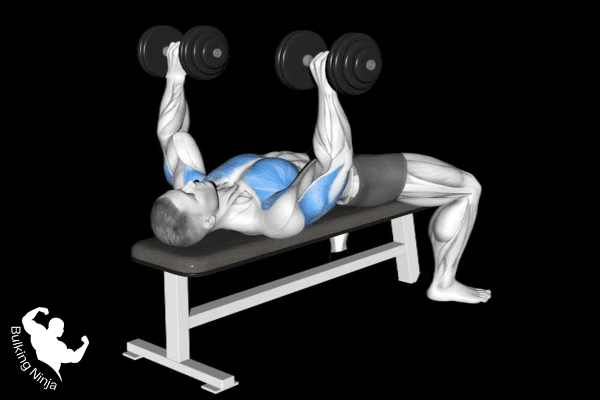
The Dumbbell Bench Press is a compound exercise that engages multiple muscle groups in the upper body. The primary muscles worked during the Dumbbell Bench Press are:
Upper Body Muscles
Upper body muscles that are also engaged during the Dumbbell Bench Press include:
Pectoralis Major (Chest Muscles)
The chest muscles, specifically the pectoralis major, are the primary muscles responsible for the pressing motion when you push the dumbbells upward.
Anterior Deltoids (Front Shoulder Muscles)
The front part of the shoulder muscles is heavily involved in lifting the dumbbells off the chest.
Triceps Brachii (Triceps)
The triceps, located at the back of the upper arm, play a significant role in extending the elbow during the pressing phase.
Secondary muscles
Secondary muscles that are also engaged during the Dumbbell Bench Press include:
Serratus Anterior
These muscles are located on the sides of the chest and assist in stabilizing the shoulder blades.
Biceps Brachii (Biceps)
The biceps help to stabilize the shoulder joint during the movement.
Rhomboids and Trapezius
These upper back muscles help stabilize the shoulder blades and maintain proper posture during the exercise.
Rotator Cuff Muscles
These muscles assist in stabilizing the shoulder joint and ensuring smooth movement during the exercise.
Core Muscles
The core muscles, including the abdominals and obliques, engage to provide stability and support to the torso during the lift.
While the primary focus of the Dumbbell Bench Press is on the chest, shoulders, and triceps, it’s a highly effective compound exercise that engages a broad range of upper body muscles, making it an excellent choice for overall upper body strength and muscle development. Proper form and technique are essential to target these muscles effectively while minimizing the risk of injury.
The Health Benefits Of Dumbbell Bench Press?
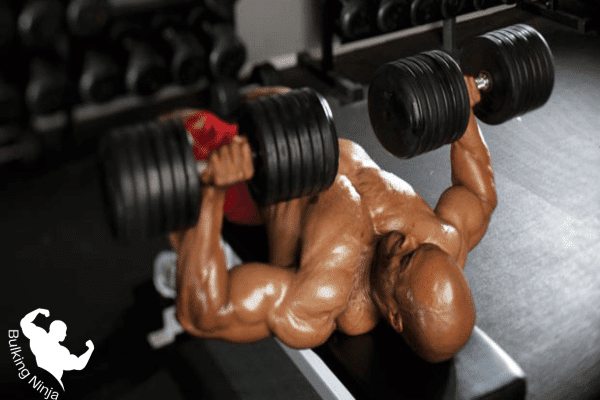
The Dumbbell Bench Press offers several health benefits when incorporated into a well-rounded fitness routine:
Strengthens Chest Muscles
The primary benefit of the Dumbbell Bench Press is its ability to strengthen the chest muscles (pectoralis major). This muscle group plays a significant role in various upper body movements, including pushing and lifting.
Enhances Upper Body Strength
In addition to the chest, the exercise engages the anterior deltoids (front shoulder muscles) and triceps. This comprehensive upper body activation helps improve overall upper body strength.
Promotes Muscle Balance
Using dumbbells requires each arm to work independently, which can help identify and correct muscle imbalances. This ensures that both sides of your body develop equally, reducing the risk of asymmetry.
Supports Bone Health
Weight-bearing exercises like the Dumbbell Bench Press can contribute to bone density and help maintain bone health. This is especially important for aging individuals at risk of osteoporosis. Start your fitness journey with study about How much Protein is required for gain muscles.
Boosts Metabolism
Compound exercises like the Dumbbell Bench Press stimulate multiple muscle groups simultaneously, which can increase metabolic rate. A higher metabolism can aid in weight management and overall energy expenditure.
Improves Posture
Strengthening the chest and shoulder muscles through this exercise can help improve posture by counteracting the effects of slouching or rounded shoulders.
Enhances Functional Strength
The strength gained from the Dumbbell Bench Press can be applied to various daily activities and sports, making it beneficial for functional fitness.
Increases Upper Body Stability
Performing the exercise requires stability and control, especially when using heavier weights. This can enhance overall upper body stability and reduce the risk of injury in daily activities.
Mental Well-being
Regular physical activity, including strength training exercises like the Dumbbell Bench Press, has been linked to improved mood and reduced stress. It can also boost confidence and mental resilience.
Weight Management
Muscle-building exercises like this can contribute to weight management by increasing muscle mass, which in turn can elevate daily calorie expenditure.
To reap these health benefits, it’s essential to perform the Dumbbell Bench Press with proper form and technique, progressively challenge yourself with weights, and incorporate it into a balanced workout routine that includes cardiovascular and flexibility exercises.
Frequently Asked Question
Benefits Of Dumbbell Bench Press With Dumbbells?
Benefits of Dumbbell Bench Press with Dumbbells:
- Eliminates muscle imbalance
- Works both limbs and arms independently
- Bridges strength and tenacity differences between dominant and non-dominant sides.
Benefits Of Dumbbell Bench Press For Females?
Benefits of Dumbbell Bench Press for females include improved upper body strength, muscle definition, enhanced bone health, better posture, boosted metabolism, balanced muscles, functional fitness, mental well-being, and the promotion of a healthy lifestyle.
Incline Dumbbell Bench Press Muscles Worked?
The Incline Dumbbell Bench Press primarily works the upper chest (clavicular pectoralis), front shoulder muscles (anterior deltoids), and triceps.
Benefits Of Dumbbell Shoulder Press?
Benefits of Dumbbell Shoulder Press include strengthening the shoulder muscles, improving upper body strength and stability, enhancing shoulder mobility, and supporting better posture.
How Much Should I Dumbbell Press Compared To Bench Press?
There’s no specific ratio for how much you should dumbbell press compared to bench press, as it varies from person to person. However, a common guideline is to aim for about 70-80% of your bench press weight when doing dumbbell presses. Adjust based on your individual strength and goals.
What Is A Good Dumbbell Bench Press Weight?
A good dumbbell bench press weight varies but generally ranges from 50% to 75% of your one-repetition maximum (1RM) for the barbell bench press. For beginners, start with lighter weights and progressively increase as you gain strength and experience.
Is it better to do bench press with dumbbells?
It depends on your fitness goals and preferences. Dumbbell bench presses offer advantages like improved muscle balance and range of motion, making them a valuable choice for many. However, barbell bench presses can allow for heavier weights and may be preferable for powerlifting goals. Ultimately, the choice between dumbbells and barbells should align with your specific objectives and comfort.
Why use dumbbells for bench press?
Dumbbells for bench press offer advantages such as improved muscle balance, a wider range of motion, and engagement of stabilizer muscles.
Average Dumbbell Bench Press? (Kg)
The average dumbbell bench press weight varies, but it can range from 10-35 kg (22-77 pounds) per dumbbell, depending on your fitness level and goals.
What is Incline Bench Press?
The incline bench press is a weightlifting exercise where you lie on an inclined bench and lift weights, typically dumbbells or a barbell, at an angle targeting the upper chest muscles.
Conclusion
In conclusion, the dumbbell bench press is a versatile and effective exercise that offers a wide range of benefits for both beginners and advanced fitness enthusiasts. By incorporating this compound movement into your workout routine, you can enhance upper body strength, build muscle mass, and improve overall chest development.
Additionally, the stability and range of motion provided by dumbbells help engage stabilizing muscles, promoting balanced muscle development and reducing the risk of injury. Whether you’re aiming to increase strength, sculpt your chest, or enhance athletic performance, the dumbbell bench press is a valuable tool in achieving your fitness goals.
So, don’t hesitate to include this exercise in your training regimen and experience the many advantages it has to offer. Get ready to press your way to a stronger, more defined upper body.
